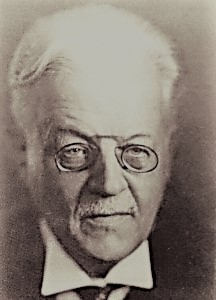Carl Nedelmann
Carl Nedelmann (born May 3, 1867 in Mülheim an der Ruhr ; † February 3, 1947 there ) was a German businessman and glass manufacturer.
Live and act

Carl Nedelmann was born on May 3, 1867, the youngest child of Ernst Nedelmann (1818–1888) and his wife Henriette Winkelmann in Mülheim an der Ruhr. He attended the Mülheim secondary school up to the prima and in 1882 obtained the "scientific qualification for one year of voluntary military service". The head of the school at that time was Dr. Oscar Henke, whose youngest son Ernst would later become Nedelmann's son-in-law.
In 1884 Carl Nedelmann began a commercial apprenticeship at the Stallmann, Itzenplitz & Schlafhorst table glassworks. After completing his two-year apprenticeship, he worked for just under a year as a trainee at the stock corporation for iron industry in Oberhausen and, after a short period in his father's business, went to Italy in 1887. There he worked in his cousin's ironmongery in Florence and Rome . When his father died in 1888, Carl Nedelmann returned to Mülheim and re-entered the service of the glassworks as an authorized signatory . He soon became a partner and in 1891 married Amalie ("Mally") Itzenplitz, who was two years his junior and daughter of the glassworks owner Max Itzenplitz. She died in 1893 after having a second daughter.
In 1895 Carl Nedelmann married a second time. Helene Wenzel was a year older than him and came from Wiesbaden , where her father worked in the coal trade. In the following years she gave birth to five children: Otto (* 1896), Ernst (* 1897), Carla (* 1899), Heinz (* 1900) and Wilhelm (* 1904).
After the death of his father-in-law Max Itzenplitz in 1906, Nedelmann became the sole owner of the glassworks. As early as 1890, in the course of modernization, the outdated furnace operation was given up and the furnace operation based on the Belgian model was introduced. The number of employees in 1910 is given as 140. Although the company was not unprofitable, Nedelmann stopped production in 1912 and sold the factory, fearing that a company based on manual labor would not be able to compete with the machine companies customary abroad in the long term.
After Nedelmann had been active as a local councilor in Styrum since 1904 , he was elected to the city council of Mülheim after Styrum was incorporated. With the beginning of the First World War he worked free of charge in various areas of war supply. His area of responsibility included the welfare of small retirees, the war kitchen , the sewing room, the gold buying point and, from 1916, the ticket office with an attached old clothing store. In recognition of this commitment, Carl Nedelmann was appointed unpaid alderman of the city of Mülheim on August 14, 1917. He was to hold this honorary position until 1930.
In the years after the First World War, Nedelmann took care of small pensioners in particular. The so-called small pensioners suffered severely from inflation and were only able to make a living with great difficulty. He made great contributions by building the Klönne-Stift , a home for needy pensioners.
As a native of Mülheim, Carl Nedelmann had mastered the language of his hometown, the Mölmsch Platt, since childhood . In this dialect he communicated with the workers in his glassworks or with the boatmen who were employed by him. Nedelmann was involved in numerous Mülheim associations. So he was Baas (chairman) of the civil society Mausefalle , commander of the Grubbel-Grabbel , head of the Mölmschen Kringks , member of the Casinogesellschaft zu Mülheim ad Ruhr Gesellschaft Casino eV and founding chairman (1891-1899) of the Mülheim tennis club on the Kahlenberg.
Inspired by his stays in Florence, Nedelmann built another imposing Art Nouveau villa, the so-called Villa Nedelmann, in addition to the Villa Schmitz-Scholl he had acquired at Delle Nr. 56 in Mülheim, which, however, was heavily destroyed by an air raid on June 22, 1943 and later was demolished. The Villa Schmitz-Scholl was spared the war. The company logo of Oskar Natorp made of steel with the distinctive N above the portal in Ruhrstrasse No. 3 (today Galerie an der Ruhr / Ruhr-Gallery) is still emblazoned there today. Wilhelm Schmitz (businessman) lived here, later called Wilhelm Schmitz- Scholl (WISSOL) with family, the founding father of the Tengelmann company. It is the historic headquarters of the group.
A few months before his 80th birthday, Carl Nedelmann died on February 3, 1947 in a traffic accident in front of his last apartment at 78 Kassenberg in Mülheim an der Ruhr.
literature
- Carl Henke: The Nedelmann family - 500 years in the service of the city of Essen . Essen, 1936.
- Ernst Henke: The Nedelmanns. A seven-century Essen family history, 1388-1937 . Potsdam, 1937.
- Jens Roepstorff: Merchant tradition and social commitment: The Nedelmanns in: Horst A. Wessel (Hrsg.): Mülheim entrepreneurs: pioneers of the economy. Business history in the city on the river since the end of the 18th century . Klartext Verlag, Essen 2006, ISBN 3-89861-645-2 , pp. 232-239.
| personal data | |
|---|---|
| SURNAME | Nedelmann, Carl |
| BRIEF DESCRIPTION | German merchant and glass manufacturer |
| DATE OF BIRTH | May 3, 1867 |
| PLACE OF BIRTH | Mülheim an der Ruhr |
| DATE OF DEATH | February 3, 1947 |
| Place of death | Mülheim an der Ruhr |

